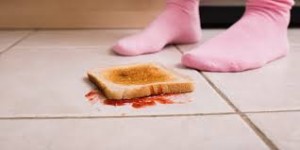We’ve all been there: we’re holding a delectable piece of food, about to put it into our mouth, when something startles us, or perhaps we’re just clumsy, and it drops. If I’m like most people, I usually pick it up and give it a glance over. If all looks good, I dust it off a little and pop it right back into my mouth without much hesitation. Everything’s good, because I’m following the 5 second rule, you know? I try not to think too hard about the 5 second rule, because if I do, it doesn’t really make much sense. I would think that the second it touches the dirty floor, thousands of germs, dirt particles, etc. become attached within a matter of milliseconds. Turns out my suspicions were correct.
The five second rule is nothing more but an old wife’s tale, that has been debunked by numerous scientists and experimental studies. One study in particular, done by professor Schaffner of Rutger’s University, looked to prove the findings of England’s Aston University’s School of Life and Health Sciences wrong after they essentially claimed that eating dropped food isn’t dangerous. Schaffner and his team of researchers tested different foods on different surfaces, and concluded that all food particles were infected with bacteria straight away. They did find however, that the longer the food was left on the floor/contaminated surface, the more bacteria it picked up. This brings a little sense to the five second rule, but considering that regardless of how long it’s been on the floor, the food still becomes contaminated, it is unhealthy to eat dropped food regardless.
The amount of moisture a particular food has is actually more important than the number of seconds we let that food sit on the floor. For instance, if one were to drop a food that is wet to the touch, such as a peeled apple or a cucumber slice, it would collect more bacteria than a dry piece of food, such as a pretzel.
Although the five second rule has been put to bed by many different scientists, researchers, and experiments, it is still prevalent in society today. Why? For one, since bacteria isn’t something that we can visibly see, people find it easier to ignore. Additionally, we like to eat food! If we intended to eat it in the first place, chances are there’d have to be a visible difference to the food, such as a hair in it or dirt that we can see, that would stop us from putting it right back into our mouths. Perhaps the most important reason we continue to abide by the five second rules is because nine times out of ten, nothing bad happens to us if we choose to eat that piece of food we dropped on the floor. Our immune systems are more likely than not able to combat the little amount of bacteria we ingest by eating something off of the floor, especially if it was dropped on a surface that is regularly sanitized (example: our kitchen floor as opposed to a city sidewalk).
I have to admit, reading about the fallacy of the five second rule confirmed what I thought to be true, but still probably won’t stop me from eating what I’ve dropped on the floor. I’ll take my chances.


I liked this article for how relatable it is to almost every person I know. However, I worked in a restaurant this past summer, and after spending hours upon hours inside a kitchen, I feel I will never eat food off the ground again. There are definitely some confounding third variables at play here, especially the cleanliness of the floor and the type of food it is. Do different foods like raw steak collect more bacteria than an apple when dropped? Heres an article that furthers the discussion on the five second rule from a credible health site: http://www.webmd.com/a-to-z-guides/features/5-second-rule-rules-sometimes-#1
You findings make a lot of sense that the moment food touches the floor bacteria has already made it’s way onto it. I’ll try not to think about that because its gross. I was wondering if the same goes for the particles and bacteria in the air. Do those get on our food the second we take it out of the bag or pick it up to eat it? Obviously those are not harmful because we can just as easily breathe them in, but I was curious as to if the same happens.
I always assumed that the 5 second rule was a myth. What were the chances that dirt and everything else on the floor waits until the 5 second mark to cover your food? It’s simply ridiculous. However, like you, most of the time I don’t care about the science behind it, but there are certain ground rules to the 5 second rule. Depending on the surface it falls on, the food could be immediately destroyed and too nasty to eat. If a piece of toast falls on a relatively clean floor, as opposed to a pile of mud, I’m probably gonna be eating that bread instead of making a new piece of toast; despite the scientific proof proving that is equally as illogical.